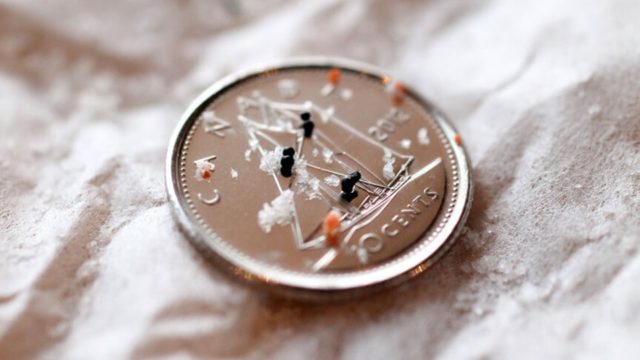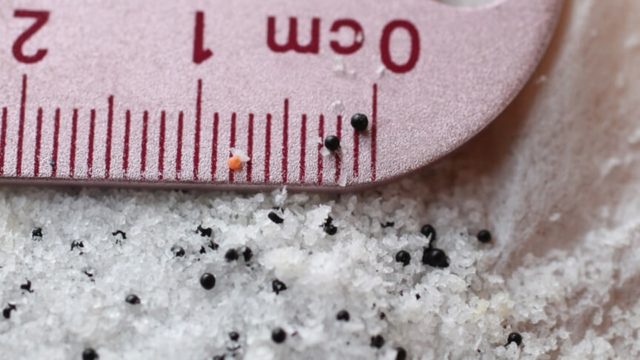Canada’s government needs to act faster than proposed to stop the flood of microbeads into lakes and rivers
It used to be said that we could achieve “better living through chemistry” and experience a world of comfort and convenience that our ancestors only dreamed of. And some have made a compelling argument that, at least in the short term, a reliance on modern chemistry has led to better living by enabling vaccines, proper sanitation, increased crop yields, etc. But even if you feel that modern chemistry has uniformly been a good thing in our lives – there can be too much of a good thing.
The federal government has recognized this and is getting ready to step in to restrict the use of plastic microbeads that end up in our lakes and rivers. But the government may not be moving quickly enough, lagging behind even our American neighbours to the south.
What are microbeads?
A little over a decade ago industry started adding tiny bits of plastic called ‘microbeads’ to all sorts of personal care products.
Microbeads are tiny plastic balls, typically under 1 millimetre in size, that are used in personal care products such as cleansers, lotions and toothpastes. Microbeads are added to some products as an exfoliant, replacing long-standing natural exfoliants such as apricot seed or ground pumice. They’re added to lotions as a lubricant. They’re added to toothpaste to provide abrasive properties and ‘sparkle’.
What’s clear is that while microbeads may once have been considered a desirable selling feature of these products, they’re certainly not essential, irreplaceable or – perhaps most significantly – important enough to warrant polluting our rivers and lakes with millions of tiny bits of plastic.
When products containing plastic microbeads are used and washed down the drain, the plastic is too small to be caught by wastewater treatment facilities, which are not designed to remove or treat microbeads. Instead, they are discharged directly into our rivers and lakes. Scientists have found millions of microbeads in parts of the Great Lakes. The highest concentration was found in Lake Ontario with counts of up to 1.1 million plastic particles per square kilometre.
How do microbeads affect the environment?
Microplastics also absorb dangerous pollutants such as PCBs and polycyclic aromatic hydrocarbons that are already present in the marine environment. When fish, birds, and other wildlife ingest these plastics, the harmful pollutants accumulate in species low in the food chain and are passed on to larger predators, eventually contaminating the fish and wildlife species consumed by humans.
Marine species are unable to distinguish between food and microplastics, and therefore often end up indiscriminately feeding on microbeads. The U.S. National Oceanic and Atmospheric Administration estimates that plastic debris kills millions of birds and fish annually, in addition to 100,000 marine mammals.
The proposed federal microbeads ban
The Government of Canada recently announced the sensible approach of banning the use and sale of microbeads in personal care products. The government is proposing to ban the manufacture and import of microbeads in Canada starting December 31, 2017, and the sale of microbeads on December 31, 2018.
What’s troubling about this otherwise welcome announcement is that the government’s proposed Canadian manufacturing ban and ban on the sale of microbeads lags behind the American government’s timeline for a ban by six months.
In the US it will be illegal to sell products containing microbeads on July 1, 2018, but in Canada, under the federal proposal, we’d have millions of microbeads flowing into our lakes and rivers for another half year!
In fact, it’s quite conceivable that Canada will become a dumping ground for microbead laden products that American retailers couldn’t sell before their deadline – thus flooding the Canadian market with discounted microbead products.
Help stop microbead pollution
You can take a stand for microbead-free lakes and rivers today. Send a comment before March 10th urging Canada’s Ministry of the Environment and Climate Change to move quickly on banning microbeads.
Wondering what you should say in your comment? Here are a few suggestions:
- Everyone, including the personal care products industry, has to take responsibility for ensuring that plastics do not enter Canada’s beautiful lakes and rivers. The federal government is to be commended for recognizing this.
- The government needs to move as quickly as possible to stop the manufacture and sale of products containing microbeads.
- Canada should not become a dumping ground for microbead-laden products that U.S. retailers can’t sell at home.
- The government should stop the sale of microbeads in Canada no later than July 1, 2018, so that we don’t have millions of microbeads flowing into our lakes and rivers for half a year longer than the U.S.
The comment period closes March 10th. Take action now and have your voice heard.
Please address comments to the Products Division of Environment Canada with the subject “Consultation on Proposed Regulations for Microbeads”. Comments can be submitted by email to ec.produits-products.ec@canada.ca or can be mailed to:
Products Division
Environment and Climate Change Canada
Place Vincent Massey, 9th Floor
351 St. Joseph Boulevard
Gatineau, QC K1A 0H3



